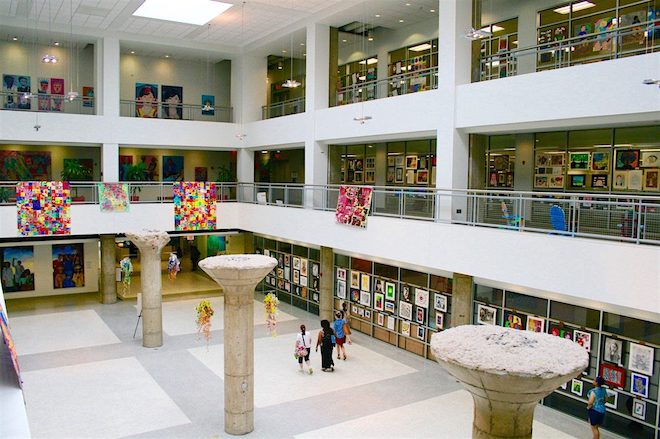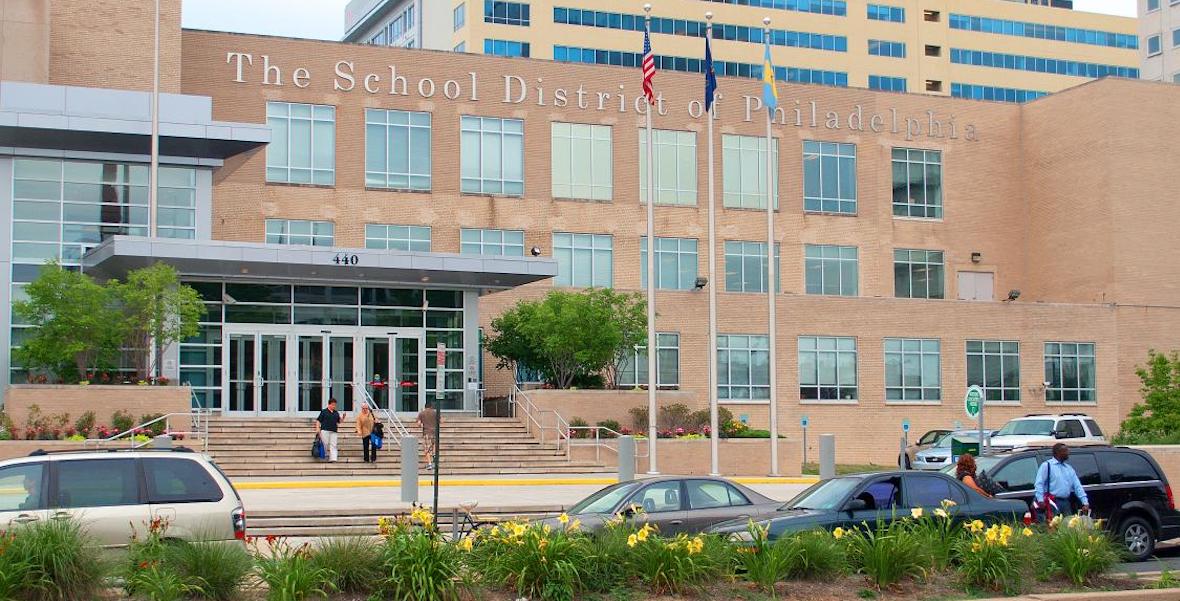I joke that the School District of Philadelphia is an echo chamber. Although I love a good buzz word — “scaffolding,” “inclusion,” “whole child,” I use the term “echo chamber” literally. When I walk down the halls of the District headquarters at 440 N. Broad, the click of my wood-soled Freda Salvadors echo in the concrete halls. Conference rooms are empty and snacks grow rancid in the vending machine.
As I try to navigate the state-of-the-art headquarters, I wonder how many of the office employees are aware of the conditions of the schools they work for (let alone have set foot in a local school recently), despite a new administration that promises to reinvigorate Philadelphia education. How many people in the central office, who define policy and manage process programmatic flows, have ever spent significant time in local school? The centralization of the District’s office distances staff from students by design.
Recently, Superintendent Watlington and the school board announced a spatial reconfiguration that includes school closures for under-enrolled schools aiming to “address enrollment trends that have created financial and operational inefficiencies, identify district schools/buildings to be modernized, co-located, repurposed or closed.” I am convinced that decentralization of headquarters in the strategic plan would transform interaction between administration and school-based staff, leading to enhanced outcomes for students and become a model for large urban districts.
Decentralization provides the living qualitative data needed to ignite transformation.
I stopped by the central office building to drop off my coworker’s laptop. I’m repeatedly reminded of the disparities between District employees — clad in white silk blouses, highlighter-colored blazers, and suede heels — and my coworkers, who look like they just attended a perpetual school prep rally, donning casual athletic bottoms, school spirit wear, and chunky cushioned sneakers.
After trying to dress to impress my first year as a teacher, I quickly adapted to functional attire like Lululemon (can I be your ambassador?) and Hoka sneakers. Trying to herd 100 students out of a Kensington high school with open-toed shoes was a recipe for disaster as we all dodged needles to get in fire drill formation. Compounded with environmental exposure to asbestos and lead paint, many buildings, unlike the fancy HQ, lack proper ventilation and functional heating and cooling — that’s not even considering environmental dangers.
School District headquarters, a looming, 890,000 square foot behemoth comprising an entire city block, is one of the most recent renovations of all school-related buildings in the District. Unlike many Philadelphia schools, it has proper insulation, functional heating and cooling, and lead-free drinking water. It’s conveniently located near a Starbucks, a brand new Giant supermarket (sushi Wednesdays, anyone?), Planet Fitness, and CVS. A new food hall is slated to be opened nearby this fall.

Most HQ staff are not required to visit any schools, and very few know how their programs are being implemented, how policies can be mutually adapted, or the culture of students and schools which is not reflected in data and according to some leading sociologists, has undoubtedly been influenced by youth culture’s isolationist tendencies. But what if District headquarters were completely decentralized? Superintendent Walington noted that some positions would be based in schools to liaise the community, but what if there was a complete decentralization process?
If District headquarters were housed in school, administrators and HQ employees would be more connected to the ongoing work in schools. As school and student culture transform rapidly, there is a growing distance between the HQ and the classroom — this is a national reality.
Decentralization provides the living qualitative data needed to ignite transformation. In a piece for the Philadelphia Inquirer last fall, I wrote, “In other words, the data were skewed by those who could throw out the ‘bad’ data before they were even collected. Faulty data led to misinformed decisions, as the data did not reflect the true school climate. In essence, the observational data were invalid and unreliable, so school issues went unaddressed.” Proximity leads to an increased understanding of the nuance and gaps in implementation with policy. School-based staff who were doing the groundwork were not engaging with the administrators making the ultimate decisions, disconnecting the data from reality.
This idea of proximity through decentralization is well known in corporate organizational theory. Countless organizational studies center on decentralizing work space so that creativity and collaboration flourish. Thomas Allen of MIT is an expert on the organization of innovation. In a decade-long study, he found that proximity matters in workplace interaction. “People seated more than 75 feet apart rarely interact at all.” Place is determining the gap between practice and policy. Writing about the significance of decentralization for the New Yorker, author and thought leader Malcolm Gladwell writes, “More precisely, as one study after another has demonstrated, the best ideas in any workplace arise out of casual contacts among different groups within the same company.”
This theory of the organization has been supported by major corporations like 3M and Apple. Ironically, this logic has been embraced by former Philadelphia Superintendent William Hite who paid a quarter of a million dollars for a new workspace a few years ago for top administrative staff. We know from countless studies decentralization works. Scholarship on strategy, innovation, and leadership necessitates that we make a physical change. Of course, departments should not be separated as learning can happen inter-departmentally — some departments should be housed in the same building.
There are far-reaching student effects to better leveraging the physical space at 440 North Broad Street. A seismic benefit would be freeing up the building for student use, which means that decrepit and underused buildings can be sold. According to architect renderings, the administration building meets the standards for an ideal school. With long hallways and corridors, it is already set up to be a place of learning for many students … In fact, with its space, it is set up to be a few schools — and recently functioned as a home for a few displaced schools. Benjamin Franklin High School, a few blocks north, until the recent move of the magnet Parkway High School from downtown, struggled with basic ventilation and asbestos while HQ employees never experienced health threats. According to records from the Inquirer’s 2018 Toxic City: Sick Schools investigation, there were eight incidences of exposed or damaged asbestos. The move affirms the District’s first guardrail defined as, “Every school will be a safe, welcoming and healthy place where our students, staff and community want to be and learn each day.”
I am convinced that decentralization of headquarters in the strategic plan would transform interaction between administration and school-based staff, leading to enhanced outcomes for students and become a model for large urban districts.
Decentralizing headquarters is not as hard of an organizational lift as one might assume. A hybrid culture of working already exists, and the District has the spatial infrastructure to support such a change. After all, according to my conversations with District employees, most internal meetings are being held on Zoom. In other words, staff are already using virtual infrastructure. Strawberry Mansion High School in the North has so much spare room that the District rents out entire floors of the school building, while my own high school has two open areas perfectly suited for office space. On top of relocation, the presence of HQ employees could provide the much-needed support for the school-based work of teachers and administrators.
School District executives and principals (who wants your boss in close proximity?) would argue that there is not enough room to move District-based staff to new locations, the school-based environmental and climate conditions do not warrant an effective workflow, or the the staff will be overwhelmed to support the school-based work, but these detractions just point to the unique challenges that teachers and school-based staff already struggle with. Having HQ staff in schools to collaboratively address issues and create policies derived from experience and teacher expertise, not to mention working more closely with students (internships anyone?), has the potential to transform student outcomes.
What I am not suggesting is pouring money into creating collaborative spaces and creating new evolving cost factors. I am not suggesting retrofitting school space in pursuit of human-led design spaces for administrators. I am aware that there would be significant protests from employees on the topic of parking, isolated neighborhoods, workplace conditions, lack of amenities, and student distractions. But these are already realities for school-based staff that have protested for decades — it just reinforces their argument. I would presuppose that if an employee were not comfortable with working in a school, then they may not be a good fit for the District itself.
I’m not proposing the complete elimination of the central administrative suite. However, there is great opportunity in having a new administration, to rethink the physical space that shapes perception of schools, students, and school-based staff. As Henri Lefebvre espoused, the construction of space is very much ideological. What is our ideology? Currently, our use of space suggests a dual environment for the workforce and students.
Currently, our use of space in Philadelphia and other urban districts suggests the priority of comfort and convenience over doing what is best for our students. We must do better, starting with Philadelphia.
Lydia Kulina-Washburn is a high school English teacher in Philadelphia.
The Citizen welcomes guest commentary from community members who represent that it is their own work and their own opinion based on true facts that they know firsthand.
![]() MORE ON PHILLY SCHOOLS FROM THE CITIZEN
MORE ON PHILLY SCHOOLS FROM THE CITIZEN



